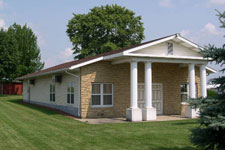
The Iowa County Historical Society was incorporated in 1976 to discover and preserve the history of Iowa County, Wisconsin, and maintains many historical archives at the Iowa County Historical Society Museum. Visitors are welcome! Our hours are Wednesday through Friday, 1 pm to 4 pm. Inclement weather affects our hours: If public schools close, we close. The Museum is located at 1301 N. Bequette St., Dodgeville, WI. View a map. Our Mailing address is P.O. Box 44, Dodgeville, WI 53533; Phone number (608) 935-7694; Email: ichistory@mhtc.net

Neighbors supporting neighbors
Wednesday, March 27, 4 to 7 pm
Culver’s of Dodgeville
Show your support for the Iowa County Historical Society while enjoying your favorite Culver’s meal.
On March 27 Culver’s will donate a percentage of their sales to the Iowa County Historical Society. The monies raised will help maintain the Dodge Mining Camp Cabin and Floyd School.
Culver’s is committed to supporting local causes and helping to keep our communities strong. This offer is only valid at the Culver’s of Dodgeville, 1122 North Johns Street. Thank you for your support!

Iowa County Historical Society Museum. Photo by Neil Giffey
Iowa County Historical Society Services
- Historical photo collections of life in Iowa County
- Obituary files and cemetery records
- Family genealogy collections which include oral histories
- Microfilm of Iowa County newspapers
- Iowa County Plat Books
- Artifacts and scrapbooks from Iowa County’s past
- Dodge Mining Camp Cabin
- Floyd School
- Archives of Iowa County surnames
- Reprints of Iowa County history books
Iowa County History Facts
The first white residents were of English, Irish, Scots, and French descent from Kentucky, Missouri, or adjacent states. The Panic of 1819 started miners moving up the Mississippi River. The end of the Winnebago war in 1827, was seen as an opportunity for miners to spread into Iowa County. Word quickly spread that lead deposits so abundant in this area that ore lay on top of the ground!
In 1827, Henry Dodge, his family, and about 40 miners set up camp in the vicinity. Within a short time, about 100 miners were working claims on the ridges of Dodgeville. By 1829, more than 4,000 miners worked in southwestern Wisconsin, producing 13 million pounds of lead a year. By the mid-1830s, news of the “lead rush” in the Upper Mississippi Valley had reached England; and a steady stream of skilled, hard-rock miners from Cornwall and Wales had begun.
Lead mining in the area went into decline during the 1850s. Many of the Cornish moved on to the copper mines of Upper Michigan, the silver mines of Colorado, and the gold mines of California. Mining was replaced by farming and mercantilism.